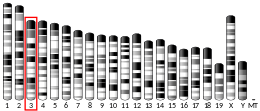Zinc transporter ZIP8
Zinc transporter ZIP8 is a cation/bicarbonate symporter protein which in humans is encoded by the SLC39A8 gene.[5][6][7]
Function
This transmembrane protein is responsible for the influx of zinc, manganese, iron, and cadmium.[8] ZIP8 is distributed among the embryo, placenta, and yolk sac during development.[9] Within the embryo, the concentration of ZIP8 is highest during the developmental period of different organ systems, specifically the heart where is it localized in the endothelial cells. Cardiac development is a zinc-dependent event. Beginning around mouse E8.0, the heart is in a tubular form with an outer myocardium layer and an inner endocardium layer, separated by cardiac jelly.[10] As development continues, trabeculation, the protrusion of cardiomyocytes into the cardiac jelly, begins and facilitates nutrient and oxygen exchange prior to the establishment of coronary vessels. Simultaneous with coronary circulation development, the trabeculae then collapse into the ventricular wall in a process known as compaction. Cardiomyocyte differentiation, proliferation, and trabeculae patterning is regulated through Notch 1 signaling, which is upregulated by the ECM. ADAMTS 1, 5, 7, 15, and 19 are zinc metalloenzymes responsible for degrading the ECM prior to compaction.[11] Many studies have analyzed the effects of Slc39a8-/- on fetal heart development and have shown a decrease in zinc influx leading to an increase in cardiomyocyte proliferation through BMP10, hypertrabeculation through the upregulation of Notch1, and ventricular non-compaction due to the persistence of the ECM.
References
- GRCh38: Ensembl release 89: ENSG00000138821 - Ensembl, May 2017
- GRCm38: Ensembl release 89: ENSMUSG00000053897 - Ensembl, May 2017
- "Human PubMed Reference:". National Center for Biotechnology Information, U.S. National Library of Medicine.
- "Mouse PubMed Reference:". National Center for Biotechnology Information, U.S. National Library of Medicine.
- "SLC39A8 solute carrier family 39 member 8 [Homo sapiens (human)] – Gene – NCBI". www.ncbi.nlm.nih.gov. National Center for Biotechnology Information, U.S. National Library of Medicine. Retrieved 19 April 2019.
- Park JH, Hogrebe M, Grüneberg M. "SLC39A8 deficiency is a novel treatable disorder of manganese metabolism and glycosylation". ResearchGate. ResearchGate. Retrieved 19 April 2019.
- Gálvez-Peralta M, He L, Jorge-Nebert LF, Wang B, Miller ML, Eppert BL, Afton S, Nebert DW (2012). "ZIP8 zinc transporter: indispensable role for both multiple-organ organogenesis and hematopoiesis in utero". PLOS ONE. 7 (5): e36055. Bibcode:2012PLoSO...736055G. doi:10.1371/journal.pone.0036055. PMC 3341399. PMID 22563477.
- Wang B, He L, Dong H, Dalton TP, Nebert DW (July 2011). "Generation of a Slc39a8 hypomorph mouse: markedly decreased ZIP8 Zn²⁺/(HCO₃⁻)₂ transporter expression". Biochemical and Biophysical Research Communications. 410 (2): 289–94. doi:10.1016/j.bbrc.2011.05.134. PMC 3136049. PMID 21658371.
- Chen J, Gálvez-Peralta M, Zhang X, Deng J, Liu Z, Nebert DW (July 2018). "In utero gene expression in the Slc39a8(neo/neo) knockdown mouse". Scientific Reports. 8 (1): 10703. Bibcode:2018NatSR...810703C. doi:10.1038/s41598-018-29109-y. PMC 6048144. PMID 30013175.
- Lin W, Li D (June 2018). "Zinc and Zinc Transporters: Novel Regulators of Ventricular Myocardial Development". Pediatric Cardiology. 39 (5): 1042–1051. doi:10.1007/s00246-018-1859-y. PMID 29536133.
- Lin W, Li D, Cheng L, Li L, Liu F, Hand NJ, Epstein JA, Rader DJ (February 2018). "Zinc transporter Slc39a8 is essential for cardiac ventricular compaction". The Journal of Clinical Investigation. 128 (2): 826–833. doi:10.1172/JCI96993. PMC 5785267. PMID 29337306.



